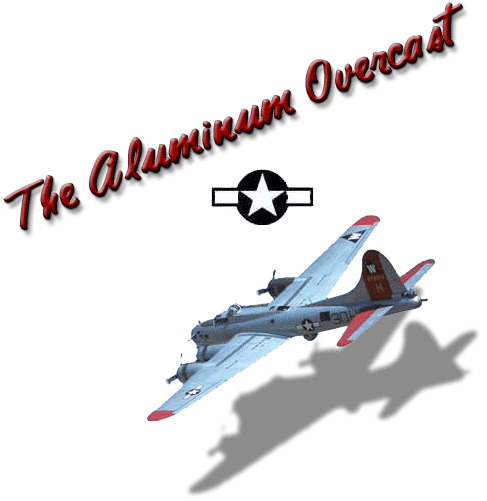![]()


During its West Coast Tour, the Aluminum Overcast, a B-17G Flying Fortress stopped at the San Francisco Maintenance Facility on October 3-10 for a 120 hour inspection. Mr. Mike Repas, an inspector for United Airlines and an EAA crew chief on the Aluminum Overcast, headed the project. Volunteers who work at United’s San Francisco Maintenance Facility donated their time and skills towards the project. There were also a few United pilots who worked on the aircraft. The inspection was very similar to a “C” Check; the same type of check that is performed on United’s aircraft.
First, the aircraft was brought to the SFO Maintenance Facility and positioned on the wash rack, where a pre-inspection wash was performed. After the wash, it was towed to dock 4 for the duration of the inspection. The inspection included open up, routine and non-routine write-ups, the fix phase and finally, the close up. The aircraft was also put on jacks for removal of the main wheel and tire assemblies. After the assemblies were sent out and inspected, they were re-installed and a gear swing was performed.
As the panels were being re-installed, a compression check on the engine cylinders was done. Within the same day, the aircraft was towed to the blast fence so the engines could be run. After few minor discrepancies were found and corrected, the Aluminum Overcast was ready to take to the skies again. On Thursday morning, October 10, the crew flew the aircraft to the Hayward Airport. Volunteers who worked on the aircraft got a flight. After four flights, the Aluminum Overcast departed Hayward to Watsonville and continued on its West Coast Tour.
PHOTO GALLERY
(Click
on a thumbnail to view a larger image)
 |
The Boeing B-17G "Flying
Fortress"

The
Boeing B-17 "Flying Fortress" is a World War II bomber used primarily
in Europe. B-17s from the Eighth Air Force participated in countless missions
from bases in England. These missions often lasted for more than eight hours
and struck at targets deep within enemy territory. Because of their long-range
capability, formations of B-17s often flew into battle with no fighter escort,
relying on their own defensive capabilities to insure a successful mission.
During the War, B-17s were among the most modern aircraft in the U.S. inventory.
However, the advent of the jet age and advances in technology made the Flying
Fortress obsolete soon after the conclusion of the War. In the years following
World War II, most B-17s were cut up for scrap, used in Air Force research
or sold on the surplus market.
In 1934, the Boeing Aircraft Company of Seattle, Washington, began construction of a four-engine heavy bomber. Known as Boeing model 299, it first took flight on July 28, 1935. The government ordered production of 13 of these aircraft, now designated the Y1B-17. Delivery of these first production models was between January 11 and August 4, 1937.
The B-17 received the name "Flying Fortress" from a Seattle reporter who commented on its defensive firepower. The B-17 underwent a number of improvements over its 10-year production span. Models ranged from the YB-17 to the B-17-G model. Throughout the War, the B-17 was refined and improved as battle experience showed the Boeing designers where improvements could be made. The final B-17 production model, the B-17G, was produced in larger quantities (8,680) than any previous model and is considered the definitive "Flying Fort." With its 13 .50-caliber machine guns -- chin, top, ball and tail turrets; waist and cheek guns -- the B-17G was indeed an airplane that earned the respect of its combatants. In addition, air crews liked the B-17 for its ability to withstand heavy combat damage and still return its crew safely home.
Between 1935 and May of 1945, 12,731 B-17s were produced. Of these aircraft, 4,735 were lost during combat missions.
Today,
fewer than 100 B-17 airframes exist and fewer still are in airworthy condition.
At one time, more than 1,000 B-17s could be assembled for mass combat missions,
less than 15 of Boeing's famous bombers can still take to the air.
Wing
Span: 103 feet, 9 inches
Length: 74 feet, 9 inches
Height: 19 feet, 1 inch
Weight: Gross Weight - 54,000 lbs.
Top
Speed: 300 mph at 30,000 ft.
Cruising Speed: 170 mph
Range: 1850 miles
Service Ceiling: 35,600
Power: four 1,200 h.p. Wright R-1820-97 radial piston engines
Armament:
13 .50 caliber machine guns
Bomb Load: 2,600 - 8,000 lbs.(long range) up to 17,600 lbs.(short range)
Crew:
Ten (Pilot, Co-Pilot, Navigator, Bombardier, Flight Engineer (top turret gunner),
Radio Operator, 2-Waist Gunners, Tail Gunner and Ball Turret Gunner
Colors: 398th Bomb Group
Website by Clark Cook


















